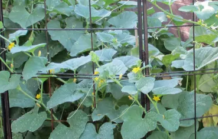The only thing worse than having a cast on my ankle is thinking about gardening with a cast on my ankle! Thinking about sweet corn makes me wish I could get in my garden now but I have to wait until my doctor says I can. Anyway, sweet corn is a popular summer vegetable but requires a significant space investment to have a good yield. Sweet corn does not adapt well to small garden areas because closely spaced plants will produce only 1 to 2 ears. Sweet corn is also wind-pollinated, and different varieties can easily cross in small spaces and impact the quality of ears. Types of sweet corn are categorized based on their genetic types.
• Normal sugary (su types). This is the oldest, traditional type of sweet corn. It is tender and creamy but will quickly become starchy. These varieties must be isolated from sh2 and sy types.
• Sugary enhanced and Triplesweet (se types). These types have an increased sugar level and even more tender kernels. The sugar turns to starch more slowly than su types. These varieties must be isolated from sh2 types.
• Supersweet (sh2 types). Supersweet varieties have up to 50% more sugar than regular sugary types. They have a crisp, crunchy texture to the kernels and will keep their sweetness for a week in the refrigerator. The shriveled seeds do not germinate well in cold soil. This variety must be isolated from other sweet corn types.
• Synergistic (sy types). Synergistic types of sweet corn have a combination of the above genes. They have at least one se gene and may have a combination of sh2 or su or both. They combine the beneficial traits of all the other genes to have improved sweetness, texture, and storage life. Isolation requirements must be determined for each variety, or plan to isolate from all other types.
• Augmented supersweet (sh2 with some se characteristics). This type of corn is a supersweet that also has the se trait in the kernels, resulting in a corn with high sugar, tender texture, and good storage life.
Variety considerations.
Many new hybrid varieties of sweet corn are available in all of the genetic categories previously discussed. The colors range from yellow to white to bicolor, yellow and white kernels together on the same ear. Early varieties that require 65 to 75 days to mature produce smaller stalks and ears, while later varieties requiring 75 days or longer produce larger plants and larger ears. Varieties are available with resistance to several common diseases such as maize dwarf mosaic, smut, and bacterial wilt. For early season planting, choose a type that is adapted to cold soils.
When to plant.
Sweet corn is a warm-season crop and should be planted in mid- to late April. The sh2 varieties and other newer varieties that have a smaller, more shriveled seed will rot in cold soil; do not plant these types until early May. Soil temperature should be at least 60°F when planting corn seed. Successive plantings of corn are important to spread the harvest over a longer period. Make additional plantings when the previous planting is ½ to ¾ inch tall.
Spacing.
Plants should be 8 to 12 inches apart in rows at least 3 feet apart. Do not crowd plantings, as weak, spindly, unproductive plants will result. Plant the kernels an inch deep. If many seeds fail to germinate, do not attempt to replace missing plants; replant the entire planting. Plant corn in blocks of at least four rows to ensure adequate pollination.
Crop rotation.
There are no major crop rotation concerns for sweet corn planted in a home garden. Do not plant sweet corn in the same location in successive years.
Care.
Sweet corn requires wind to transfer pollen from the tassel (male) to the ear (female). Plant corn in small blocks or several short rows rather than a single row to encourage better pollination. Sweet corn pollinates poorly in 100-degree weather, and ears with missing kernels or gaps may result.
Another option for isolating sweet corn varieties is by time. One way to do this is to plant multiple varieties with significant differences in days to maturity (about 2 weeks) so that pollen production does not occur at the same time. You can also plant one variety earlier than another variety to ensure the time differential in pollen production.
Sweet corn is a member of the grass family and needs considerably more nitrogen fertilizer than other garden plants. A side-dressing of additional fertilizer sprinkled along the row every several weeks is important. Sweet corn needs regular watering as well because its sparse, inefficient root system does not reach to deep soil water. Apply 1 to 1½ inches of water per week. Weed control is necessary, especially in young plantings.
Harvesting.
Sweet corn is ready for harvest when the juice in the kernel appears milky as you puncture a kernel with your finger. The ear should be well filled to the tip. This ideal harvest stage lasts for only a few days in hot weather, and regular checking for maturity is important. The silks of mature ears are generally completely dry and brown. Twist and pull the ear from the plant by bending the ear down sharply. Use corn immediately or store it in a cold place immediately after harvest. Pick corn early in the morning when it is cool outside. Store corn for only a few days in a refrigerator before using. Corn is easily frozen for later use.





